

| This educational section is for an in-depth view of one of nature's most powerful storms: TROPICAL CYCLONES! These storms are those whirlpools that develop each tropical season over the tropics, what we call "hurricanes" in the Atlantic and East pacific and "typhoons" in the West Pacific. These storms have a very special place in the meteorological world and will be explained in great detail in this section. Note - This page may take a while to load on some SLOWER connections! |

|
Tropical Wave: This is a low pressure trough (a non-closed low pressure area) moving through the trade winds over the tropical ocean. As many as 100 of such waves (also called inverted troughs, because of their "upside down" appearance on a tropical weather map in the northern hemisphere) move across the tropical Atlantic during the hurricane season for that region, which lasts from June 1 to November 30. Sometimes, such tropical waves can develop enhanced showers and thunderstorms, creating a low pressure area that can further develop into a tropical cyclone (such as a tropical depression or even a tropical storm). On average, about six of such tropical waves go on to becoming a "named" tropical cyclone (tropical storm status or greater) during each Atlantic hurricane season. In the annotated satellite picture, the yellow arrows show a northeast wind ahead of the westward (left) moving wave then a southeast wind behind the convergence line. Since no westerly winds yet exist south of the system, the tropical wave is basically an "open" or "north-south" axis of low pressure (a trough). |
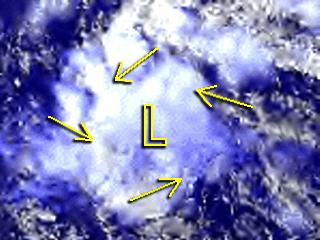
|
Tropical Disturbance: This is a weak or broad area of low pressure. It can be associated with a developing tropical wave or within a developing area of convection over the tropical ocean. This is a cluster of convective clouds (showers and thunderstorms) that has become persistant and has the potential to develop into a tropical depression. Winds within such a system are normally well under 25-30 MPH. Persistant tropical convection tends to lower surface pressures (called a CONVECTIVE VORTEX), and is vital to tropical cyclone formation under the right conditions (warm sea surface, minimal upper-level wind shear, etc). Besides developing along a tropical wave, tropical broad lows can also form along stalled frontal systems, even remnants of previous tropical storms. |
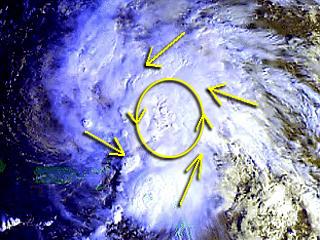
|
Tropical Depression: This is a tropical cyclone with winds of over 30-MPH but less than 38-MPH. A tropical depression must be a CLOSED low pressure area (at least one closed isobar on a 2-MB pressure interval weather map) to be classified as such. This is the first major stage in tropical cyclone / tropical storm formation. |
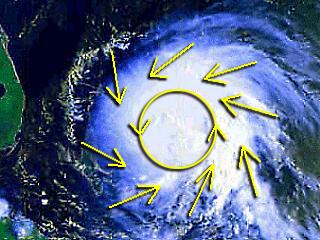
|
Tropical Storm: Is then the maximum sustained winds (a one-minute mean windspeed at sea level) in a tropical cyclone reaches 38-MPH but less than 74-MPH. The tropical storm usually has well-developed closed cyclonic circulation. Tropical storms are the stage inwhich the tropical cyclone is given a name from a list of names unique to the area that tropical cyclone developed in. In the Atlantic basin, an alphabetic list of alternating male and female first names is used that repeats every six years. A major hurricane or storm that causes exceptional damage and / or loss of life is usually removed from the list and replaced with a new one to avoid confusion 6 years later. |
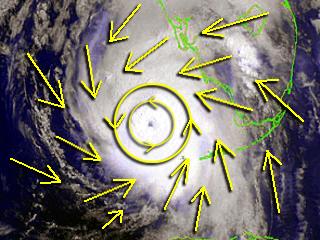
|
Hurricane: This is the most intense stage of tropical cyclone development. The term "hurricane" (or other name such as "Willy-Willy" in Australia and "typhoon" in the west Pacific) is applied to any tropical cyclone with winds at or over 74-MPH. Hurricanes (called so in the East Pacific and Atlantic) are derived from an Indian name for "bad winds", and represent a tropical cyclone with an intense closed cyclonic wind flow and pressure structure. Once at the hurricane stage, the tropical cyclone is now classified by its destructive power on what is the SAFFIR-SIMPSON scale, rating the storm based on how much damage its winds can do on a scale from 1 to 5. The highest winds ever measured in a hurricane or typhoon have exceeded 200-MPH. |
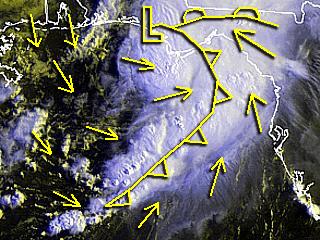
|
Extratropical Storm: As a hurricane, typhoon, tropical storm, or any tropical cyclone enters the higher (temperate) lattitudes, it begins interacting with the increased temperature gradient as you go from south to north (or north to south in the southern hemisphere). This is where cool, drier air is brought in on one side of the dying tropical cyclone and warmer air is brought in on the opposite side. In the annotated picture, a tropical cyclone has evolved to an extratropical (frontal) system. To its west, cool air had formed a cold front, while warm air surges north east of the remnant low pressure. Note the thunderstorm line along the cold front and drier air "punch" to its west. These extratropical (or even subtropical "hybrid" - as described in the next section) type stages do not always mean the storm is "weakening", but simply "changing" in response to a different environment it was introduced into. In the past, hybrid or extratropical storms of tropical cyclone orgins have caused exceptional flooding events (Such as Agnes in 1974) even wind and / or coastal damage events (such as "The Perfect Storm" in 1991). |

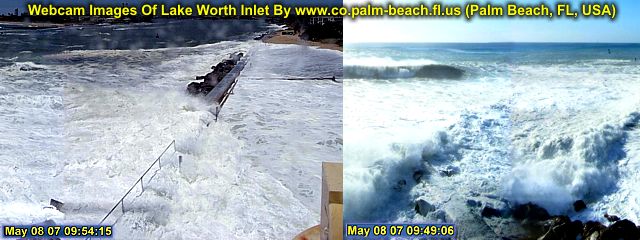

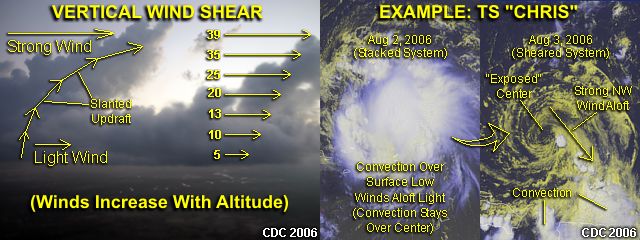

|
Category One: Winds 74 to 95 MPH. Tree and shrub damage. damage to shingles. un-anchored mobile homes damaged. Storm surge about 3-5 feet. Damage to piers and boats. Examples: Irene in FL Keys in 1999, Gabrielle in FL in 2001, Erin in East-Central FL in 1995. |

|
Category Two: Winds 96 to 110 MPH. Roof and window damage to buldings. heavy damage to trees and shrubs. heavy damage to mobile homes. Storm surge typically 5-8 feet. Boats and piers heavily damaged. Examples: Frances in East-Central FL in 2004, Isabel in NC in 2003, Lili in LA in 2002. |
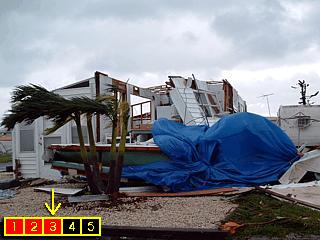
|
Category Three: Winds 111 to 130 MPH. Structural damage to buildings. Flying debris. Severe tree and shrub damage. Mobile homes destroyed. Storm surge typically about 8-12 feet. Storm surge destructive to any low lying coastal areas. Examples: Ivan in FL Panhandle in 2004, Gloria off NC in 1985, Betsy in FL in 1965. |
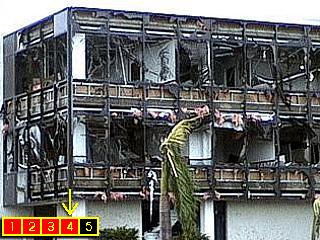
|
Category Four: Winds 131 to 155 MPH. Extensive damage to most buildings, including complete wall and / or roof failures. Debris becomes deadly missiles. Major coastal flooding with damage and extreme beach erosion. Storm surge can be 12-18 feet. Examples: Charley in SW FL in 2004, Hugo in SC in 1989, Donna in FL in 1960. |
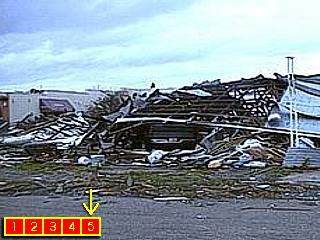
|
Category Five: Winds at or above 156 MPH. Catastropic damage to many buildings, even re-inforced buildings receive major structural damage. Debris battering. Most roofs are blown off. Deforestation of wooded areas. Storm surge over 18 feet (maybe up to 25 feet, or more). Scouring of coastal structures. Category-five storms are very rare. Examples: Andrew in South FL in 1992, Gilbert in Carribean in 1988, Camille in MS in 1969. |
The Saffir-Simpson scale was developed by a former director of the National Hurricane Center and a structural engineer to rate a hurricane (or severe tropical cyclone) winds in terms of how much damage is done. This scale ONLY applies to tropical cyclones with winds at or over 74 MPH (hurricanes in the western hemisphere). This scale is the standard in hurricane forecasting eversince.
Note: There is one addendum I would like to add to this table about the Saffir-Simpson scale above ... Which is VERY important. The STORM SURGE heights shown are basically for an AVERAGE structured hurricane (25 mile-wide eye) with a fully-developed ocean state / wave envelope that has been nearly a steady-state, and affecting an average coastline. Smaller hurricanes can have a lower storm surge (as with hurricane Charley in 2004, where a storm surge of only 6-8 feet was present, despite 150-MPH category-4 winds). Larger hurricanes, or hurricanes that are rapidly weakening, can have a much larger storm surge despite weaker winds (such as Katrina in 2005 which had a 25 foot storm surge despite category 3 winds) ... This is very important to consider as coastline, sea floor topography, hurricane size, structure, and intensity trends can make the storm-surge versus category height guide practically useless!

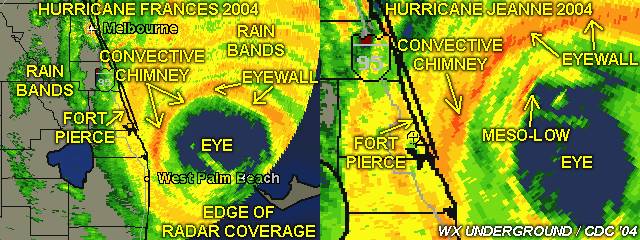
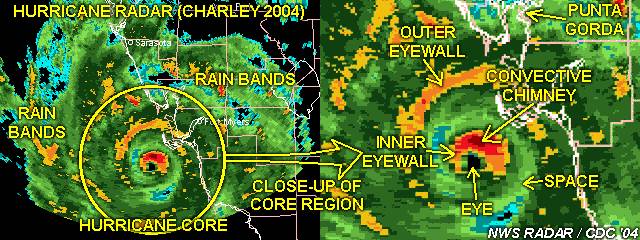
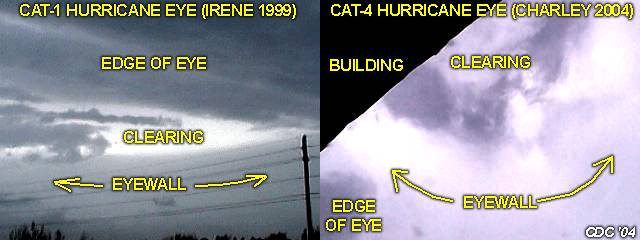
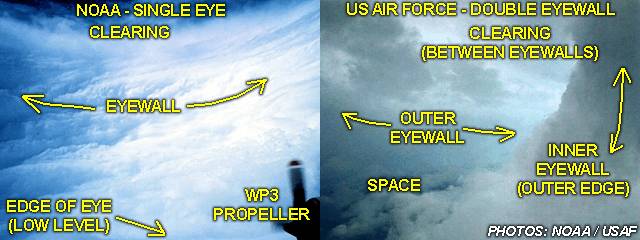
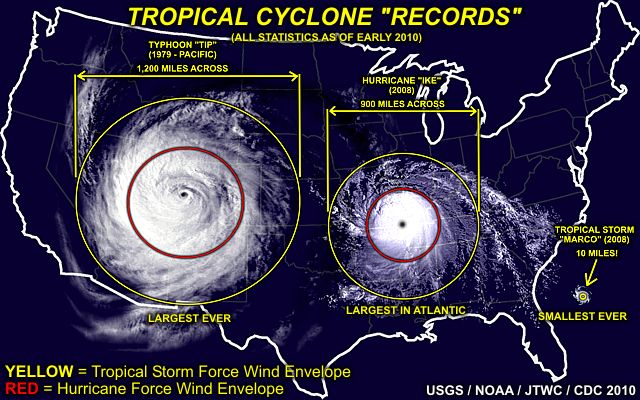
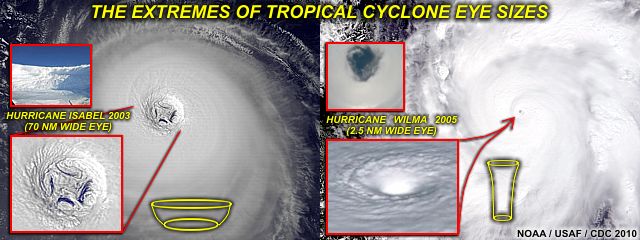
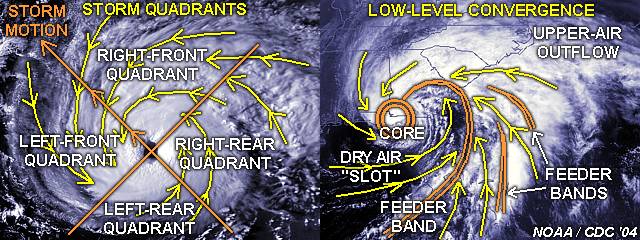
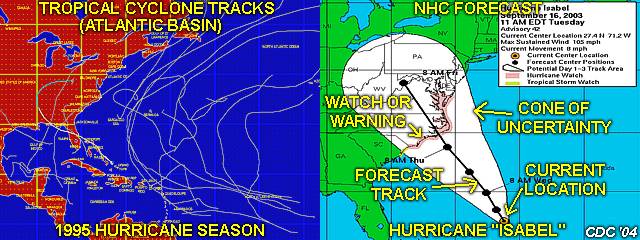
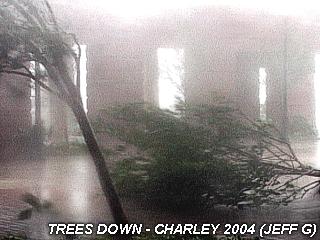
|
Strong Winds: The most obvious element in a hurricane (or any strong tropical cyclone) is the strong winds. Technically, any wind over gale forced (tropical storm forced begins at 38-MPH) can do damage by uprooting trees and damaging property. When winds reach 74-MPH or higher, damage increases radically, with each 50% increase in windspeed doubling the dynamic force of that wind. For example: A 75-MPH wind is TWICE as damaging as a 50-MPH wind, 100-MPH wind is FOUR-TIMES as damaging as 50-MPH, and a 150-MPH wind is NINE times as severe as 50-MPH! This is because the DRAG FORCE of wind, caused by aerodynamics and dynamic pressure of the wind flow, increases with a formula related to the SQUARE of the velocity. This is why a minimal hurricane with 75-MPH winds only causes leaf and minor tree damage but a hurricane like Andrew with 165-MPH winds back in 1992 can destroy an entire city. |
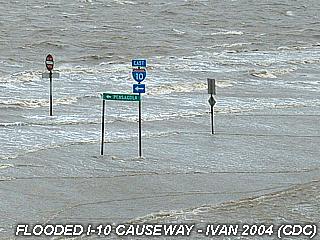
|
Storm Surge: This is basically a dome or "mound" of water caused by the intense low pressure of a tropical cyclone coupled with the driving-force of the winds "pushing" the water along (mass transport). In deep water, the storm surge in intense tropical cyclones is only a foot or two high, caused by the low pressure, but contains a fast moving surface current called MASS TRANSPORT that flows with the storm winds (more enhanced to the right side of the storm core in the northern hemisphere). As this flow (and "mound") of water comes ashore, it interacts with the coastline, tides, and undersea topography and can be over 20 feet high in strong hurricanes! Storm surge rises quickly with the onset of the storm core and often floods coastal areas, threatening life by drowning, damaging beachfront property, marinas, even the coastline itself. Storm surge is most severe in and to the right (northern hemisphere) where the storm center crosses a coast. 90% of hurricane victims die from drowning in floods caused by the storm surge. |
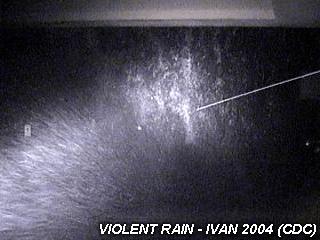
|
Heavy Rains: The rain bands and thunderstorms associated with a tropical cyclone, regardless of its wind intensity, are often heavy and accumulating. Such heavy rains can even occur well inland from weakening tropical systems, such as the incredible flooding from the remnants of hurricane Agnes (in NY) back in 1974. It is not uncommon for a tropical system to dump 10-15 inches of rain as it moves over a given area. Slow moving systems, such as hurricanes Irene (S FL) in 1999 and Mitch (Central America) in 1998 have dumped 20 to 30 inches of rain, respectively. Other tropical cyclones only dump a few inches of rain, especially if moving fast. Rain from tropical cyclones, especially hurricanes (referred to as "violent rain"), is nearly impossible to measure, because it falls "sideways" with the winds and "misses" the rain guages. I have seen wind blow water into a building wall "coating" it with several inches of water. Between gusts, when the wind let up briefly, all that water came cascading down at once in a waterfall! |
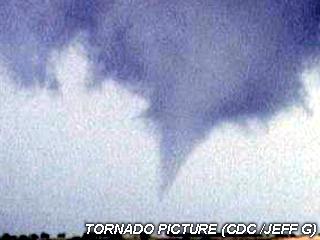
|
Tornadoes: The spiral bands of a hurricane (or tropical cyclone) also have the capability to spawn tornadoes. Tornadoes can occur in any area of the tropical cyclone but the threat is much higher on the right-front side of the storm (northern hemisphere) because the low-level convergence and directional wind shear (helicity) is higher in that region of the storm. Often the leading rain bands spawn shallow MESOCYCLONES (rotating updrafts) that could produce a brief tornado, although these mini-supercells are much smaller than their "Great Plains cousins". Tornadoes can and have occurred in land-falling tropical systems (land creates more low-level drag and shear). Some tropical cyclones spawn more tornadoes than others, depending on the structure of the precipitation. There are even eyewall tornadoes (not to be confused with MINI-SWIRLS, which are simply eddies embedded in the eyewall winds). For example: Hurricane Beulah in 1967 spawned over 115 tornadoes! |
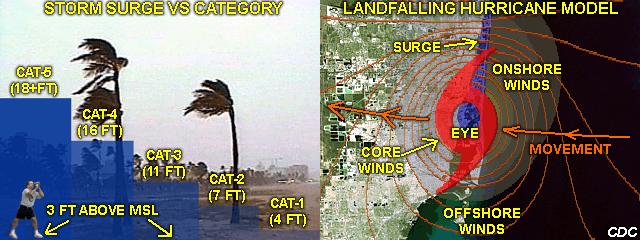
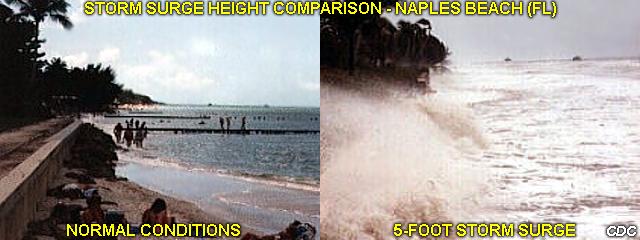



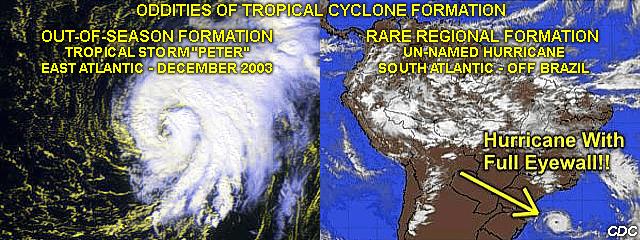
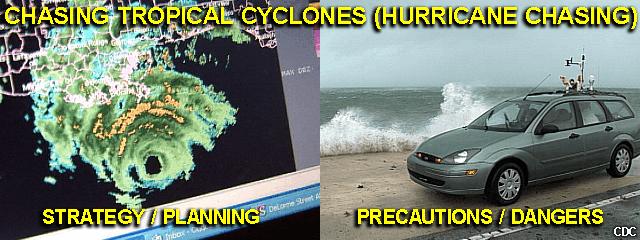


HTML File "schurr.htm" - Developed By Chris Collura
To Return To The HOME Page Of This Site Click The "INDEX.HTM" Link Here!